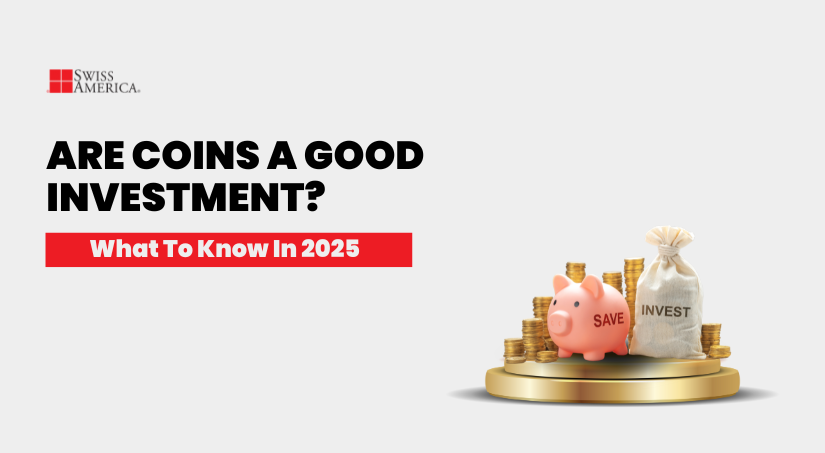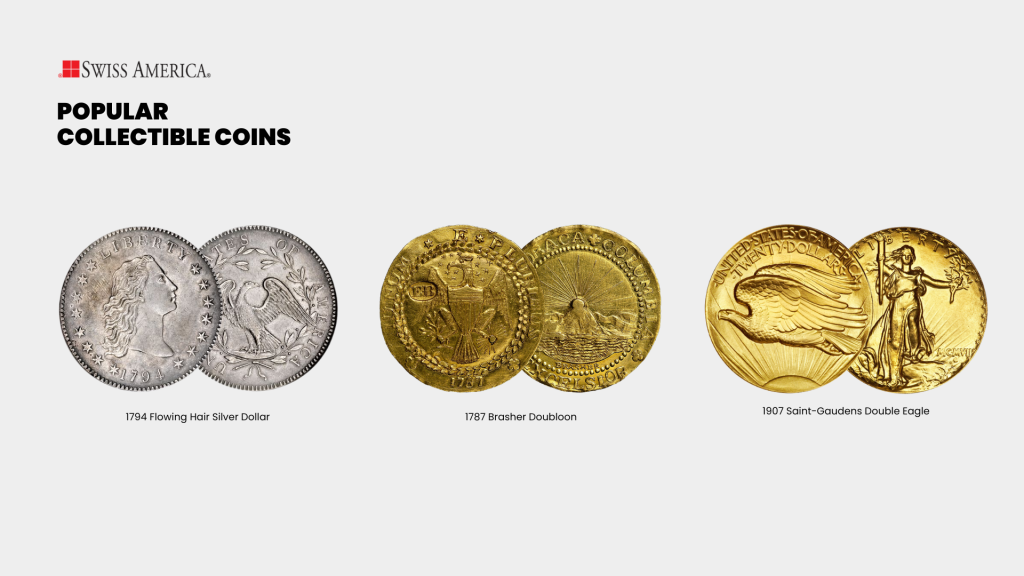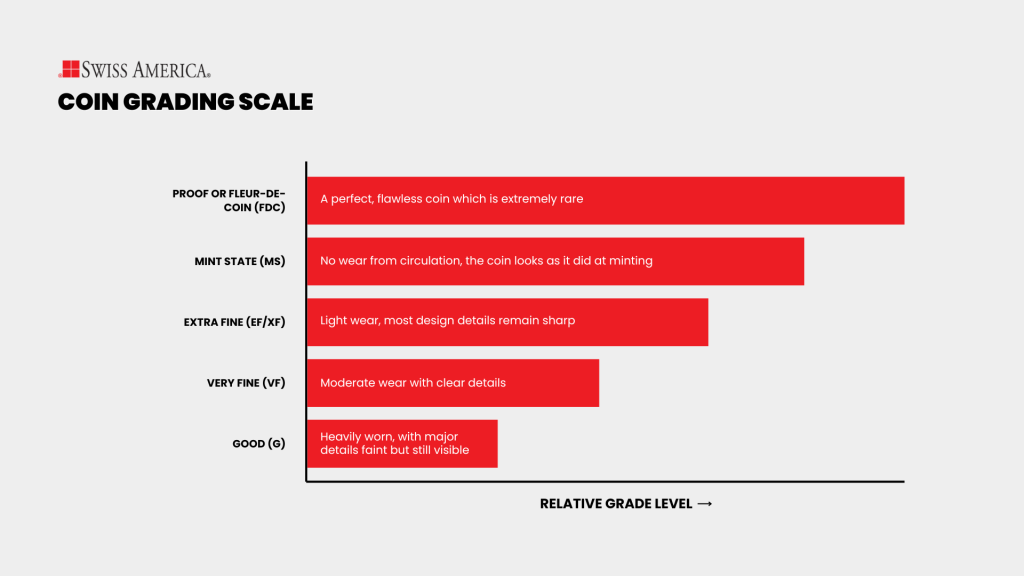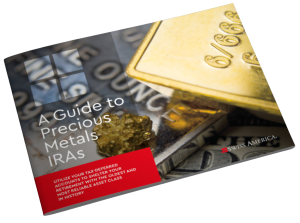
Right now, gold is sitting near record highs, inflation is still a concern, and investors are searching for safe places to put their money. That has many people asking, are coins a good investment or simply a collector’s hobby?
The same forces driving interest in precious metals are drawing attention to rare coins. Investors want tangible assets they can hold in their hands, something to diversify their investment portfolio and balance out the uncertainty of the stock market.
Investment coins vs rare coins
When you go to buy gold coins, options include investment-grade coins referred to as bullion and rare, or “numismatic,” coins. Here are the differences between them:
| Feature | Investment coins (Bullion) | Rare coins (Numismatics) |
| Value | Gold/silver content & market price | Scarcity, history, grade, & collector demand |
| Liquidity | Very liquid, easy to sell worldwide | Lower liquidity, specialized buyers needed |
| IRA eligible | Yes | No |
| Risk level | Lower (tracks gold prices) | Higher (subjective, collector-driven) |
| Premium over precious metal value | Low | High |
Investment coins
These are modern bullion coins like the American Gold Eagle, Canadian Maple Leaf, or Austrian Philharmonic. Their value comes almost entirely from gold content and global market prices. For example, if gold is trading at $3,400 an ounce, the price of an American Eagle will closely follow that spot price, with only a small premium added by coin dealers.
That makes them straightforward, transparent, and easy to sell anywhere in the world. They’re also IRA-approved, which means you can hold them in a self-directed retirement account without running into IRS issues.
Rare coins (Numismatics)
Rare or collectible coins are different because they may carry additional value based on scarcity, age, and condition. This category includes historic coins minted hundreds of years ago or proof coins with limited production runs. These can appreciate in value, but the rare coin market is far more specialized and subjective.
You’re betting on the gold inside to rise in price, plus collector demand, grading standards, and auction trends. The IRS does not allow numismatic coins in a Gold IRA, because their value isn’t tied directly to metal content.
Understanding rare coin collecting
Rare coin collecting is a blend of history, artistry, and economics. Collectors and specialized investors look at several factors when determining a coin’s worth:
- Scarcity: The fewer coins minted or surviving today, the greater the potential value.
- Historical significance: Coins linked to important eras, rulers, or events often have a higher price.
- Condition (grading): A coin’s grade (certified by services like PCGS or NGC) can mean the difference between a modest price and one worth many times its gold content.
- Unique features: Proof coins, minting errors, or discontinued designs increase collector demand.
Coin collectors buy these coins for reasons that go beyond profit. They offer a tangible connection to history, often tied to past civilizations or defining moments in time. Many of the coins also have intricate designs and craftsmanship that make them miniature works of art. They can also be a legacy that enables you to pass on your coin collection as heirlooms.

Coin grading basics
Condition is everything in coin collecting. A small scratch or touch of wear can mean the difference between a coin worth just above melt value and one that sells for many multiples of its gold content. That’s where coin grading comes in.
Professional services like the Professional Coin Grading Service (PCGS) and the Numismatic Guaranty Company (NGC) certify coins and assign them a grade. This gives buyers confidence in what they’re purchasing and helps establish fair market value.
The most common grading terms you’ll see include:
- Good (G): Heavily worn, with major details faint but still visible.
- Very Fine (VF): Moderate wear with clear details.
- Extra Fine (EF/XF): Light wear, most design details remain sharp.
- Mint State (MS): No wear from circulation; the coin looks as it did when struck.
- Proof or Fleur-De-Coin (FDC): A perfect, flawless coin which is extremely rare.

Coin grading companies give coins a number grade from 1 to 70 (the Sheldon Scale). A “1” is barely recognizable, while a “70” is perfect. At the higher end, even a tiny difference matters. For example, an MS-64 and an MS-65 coin may look nearly the same to beginners, but the MS-65 could be worth thousands more.
Because grading can dramatically impact price, beginners should rely on coins that come with certification from PCGS, NGC, or another recognized authority. This minimizes disputes about quality and protects you from overpaying.
Benefits of rare coin investing
While most investors focus on bullion for its simplicity and direct link to gold prices, rare coins can also offer:
- Potential for higher returns: Because coin value depends on rarity, history, and collector demand, rare coins can sometimes appreciate far beyond their melt value. Exceptional coins have sold for many multiples of their gold content.
- Diversification beyond bullion: Rare coins don’t move in lockstep with gold prices. Their value can remain strong even if bullion prices dip, since demand comes from coin collectors as well as investors.
- Tangible historical asset: Collecting coins allows you to combine financial value with cultural and historical significance.
- Legacy value: Many families pass rare coin collections down through generations, making them both a store of wealth and a meaningful heirloom.
- Limited supply: Rare coins have a permanently fixed supply, which drives long-term scarcity value.
Risks of collecting rare coins
Collecting coins does have benefits, but there are also risks that make them very different from bullion investing:
- Market subjectivity: Values depend on collector demand, grading, and historical interest, which can shift quickly and unpredictably.
- Lower liquidity: These coins aren’t as easy to sell as bullion. This is because they need specialized buyers, auctions, or dealers, which can take time and reduce liquidity.
- High premiums: Rare coins usually sell at a higher markup over their metal content, which means you’re paying for collectibility rather than just gold value.
- Counterfeit risk: Numismatics can be more prone to forgeries, so you’ll want to stick with reputable dealers and use professional grading to verify authenticity before you buy.
- Not IRA-eligible: Since their value isn’t based just on metal content, the IRS doesn’t allow them in a Gold IRA, which means you miss out on the tax benefits bullion offers.
Getting started with collectible coins
If you’re interested in rare coins, the key is to start small and treat it like both a hobby and an investment. Here’s how to begin:
Educate yourself
Take time to learn about coin grading, minting history, and what makes certain coins valuable. PCGS and NGC offer helpful resources on coin collecting. Joining a coin club or visiting coin shows is also a great way to connect with experienced collectors and see how the market works in real life.
Begin with a budget
Decide how much of your portfolio you want in rare coins and stick to it. These coins should be a smaller, speculative part of your overall strategy. When you’re just starting, focus on coins with established markets and strong collector demand, such as historic United States coins or early American Eagles. This gives you a safer entry point before moving into more specialized areas.
Protect condition and value
It’s important to protect your coins if you want them to hold their value. Most collectors keep them in protective cases or holders that prevent scratches and handling wear. Even a tiny mark can lower the grade and cut into what a buyer is willing to pay.
For higher-value coins, insured storage can be a good idea. Some people use a safe at home, while others prefer a bank box or a professional depository that specializes in precious metals.
Take your time
Rare coins aren’t something you flip quickly. Their value builds over time and often depends on finding the right buyer, which rarely happens overnight. Collectors and investors should think of buying coins and holding them for years, not months. Focus on quality coins you’ll feel confident holding for the long haul, because rare coins tend to reward patience and a steady approach.
Avoiding fraud in coin collecting
Like any area where money changes hands, coin collecting attracts its share of bad actors. The most common problems are overgraded coins, inflated prices, or outright counterfeits slipping into the market. A new coin collector can be especially vulnerable if they rush into buying without knowing who they’re dealing with.
The safest approach is to work only with established dealers. Reputable sellers are members of groups like the American Numismatic Association (ANA) or the Professional Numismatists Guild (PNG). They’ll also provide grading certificates from third-party grading services. If a dealer balks at offering proof of authenticity, that’s a red flag.
It’s also wise to double-check claims. The Federal Trade Commission has issued repeated warnings about false promises like guaranteed buybacks or inflated “current values.” A little skepticism goes a long way. If a deal looks too good to be true, it usually is.
For extra peace of mind, many collectors rely on their local coin clubs, where word gets around quickly about which dealers are trustworthy. Others get second opinions before spending serious money. In a market where a slight difference in grade can mean thousands of dollars, that extra step is worth it.
Final thoughts about coin collecting
Coins can be a great investment, but they also offer more than that. Bullion coins give you a safe and simple way to hold gold or silver, while rare coins add history and character that people have valued for centuries. Some buyers look at their coin collection as protection against inflation, while others enjoy the thrill of collecting and the pride of passing a tangible asset on to the next generation.
There is no single way to approach coin investing. The important thing is to decide what you want coins to do for you and build from there.
If you are interested in learning more, the team at Swiss America has been helping people understand the coin and precious metals market for decades and can help guide you through the options.
Are coins a good investment: FAQs
Is it worth keeping coins?
Yes, keeping rare coins can be worth it. They often appreciate significantly over time, serving as a tangible and inflation-resistant investment. Many rare coins have outperformed traditional assets while also providing both historical value and portfolio diversification for collectors and investors.
Which coins are best to invest in?
The best coins to invest in are rare key-date U.S. coins, as these coins consistently show strong price appreciation and high demand among collectors and investors. Coins with low mintage and historical significance, especially those certified in top condition, tend to do well for long-term investment.
What coins go up in value the most?
Coins like the 1933 Saint Gaudens Double Eagle, Brasher Doubloon, and 1913 Liberty Head Nickel consistently go up in value the most, often reaching multi-million dollar auction prices due to their rarity and historical significance. Key-date coins such as the 1893-S Morgan Dollar also see strong appreciation year after year.
The information in this post is for informational purposes only and should not be considered tax or legal advice. Please consult with your own tax professionals before making any decisions or taking action based on this information.
